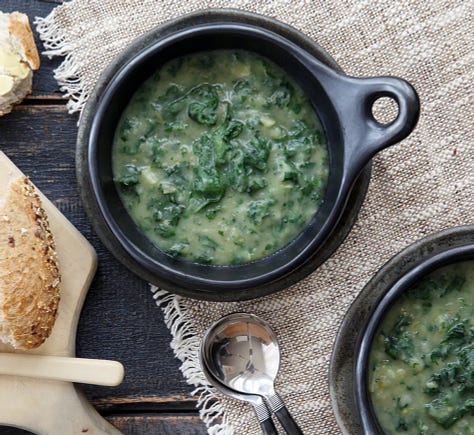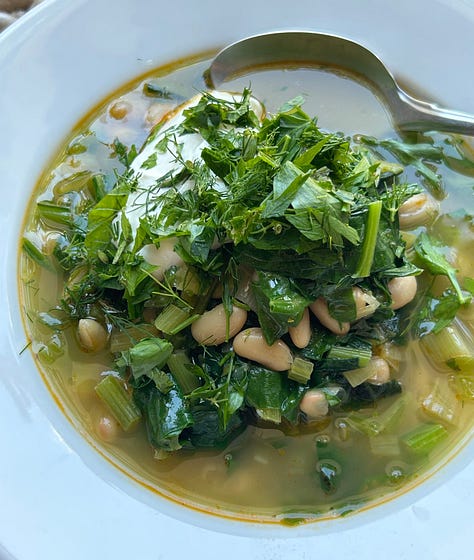In Season Right Now: Silverbeet
Everything you need to know about cooking, growing, and eating this brilliant leafy green. Plus ten delicious recipes that make the most of the season's bounty.
Hello,
We hope you are all keeping well and eating well! We are excited to launch a new monthly free email — produce highlights. Starting with one of our favourite leafy green vegetables, silverbeet (or chard as our American readers would say).
There are many reasons to love this hearty green vegetable — it grows well throughout the year, is inexpensive, wonderfully nutritious, and easily transformed into many a delicious meal.
Flavour Profile
Silverbeet has a mild, earthy flavour, with a hint of bitterness in the leaves and sweetness in the steams. When cooked, the bitterness softens and the sweetness is gently coaxed out. Silverbeet has a dense stem and tender leaf, so we will always separate the leaves from the stems and cook them separately (the stems will need to cook for longer).
Green and rainbow silverbeet can be used interchangeably — we prefer rainbow for the added polyphenols from the colours, but bear in mind that the colours will leach and muddy when cooked. If you want to keep it verdant and bright, stick to greens.
Silverbeet is in the same family as spinach and beetroot (Amaranthaceae) so shares some similarities in flavour profiles and health benefits (silverbeet leaves taste quite similar to beetroot leaves). You can happily sub in silverbeet leaves for spinach — the taster will be a little earthier and it does not break down/reduce to quite the same extent as spinach, and so takes a little longer to cook.
Growing Silverbeet
Silverbeet is one of the easiest vegetables to grow. It grows year-round, thriving in both the heat of summer and cold of winter, and is equally happy in containers and garden beds. For successful all-year-round cropping, you need to do two plantings of silverbeet a year. Plant in March/April/May for harvesting in June, July, August, September, and October. Then plant your next crop in October/November for harvesting through the summer months. When you see a big thick stem forming from the base of the plant with small leaves forming off the sides, that is the signal that the plant is starting to go to seed. Be sure to keep the plants well-watered during the hotter months as stressed plants will bolt and go to seed.
When sold as small seedlings there can often be 2–3 small plants per plug. When it’s still cool and the soil is moist you can carefully tease out the roots and plant out individual plants; if you plant the plants together as one they won’t get as big, but if it’s hot and dry (i.e. summer and early autumn) the strain you put on the little plants by trying to separate them usually does more harm than good.
The plants like friable, well-drained soil, and as a leafy green, they enjoy nitrogen. Sheep and horse manure are good fertilisers, as are blood and bone, compost, and worm castings. Beetroot, lettuce, parsley, and basil are all good companions to silverbeet.
To harvest, cut leaves and stems off the plant as required, don’t pick or cut the whole plant. You should get pickings for many weeks if not months.
Health Benefits
Silverbeet is packed with vitamins A, C, and K, as well as minerals like magnesium, potassium, and iron. It also contains fiber, which is beneficial for digestion.
Silverbeet contains antioxidants, including beta-carotene, lutein, and zeaxanthin, which help protect cells from damage and support eye health.
Silverbeet is high in phytonutrients, which can help reduce inflammation.
The potassium and magnesium in silverbeet contribute to cardiovascular health by helping to regulate blood pressure. The fiber in silverbeet can also help reduce cholesterol levels.
High levels of vitamin K, along with calcium and magnesium, support bone health and help prevent osteoporosis.
Some studies suggest that silverbeet may help regulate blood sugar levels, making it beneficial for people with diabetes or those at risk of developing diabetes.



Cooking with Silverbeet
Like most leafy green vegetables, silverbeet needs a bit of encouragement to shine — olive oil, garlic, and lemon are always a good place to start. As with spinach, you will be amazed at how much a big bunch of silverbeet cooks down, so don’t be alarmed when a recipe calls for a lot.
As a side dish, we like to cook silverbeet the way they do in Croatia, which delivers a tender and succulent result — first sauté the stems with finely diced onion or shallot in some olive oil with a little salt until they are softened but not brown, and then add the greens with a good splash of water( 3-4 tbsp) covering the pot and cook until the greens have wilted down and are also tender( 5-8 minutes) and all the water has evaporated. Season with pepper and serve with a drizzle of good olive oil. This is also great on toast with a poached egg and some thick Greek yoghurt for a hearty, healthy breakfast.
Whenever we get sick or run down, one of the first things we make is this wonderful Green Goodness Soup — loaded with greens and alliums, it’s often the immune-boosting nourishment our body needs to get back on track. This recipe calls for silverbeet and kale, but you can make this with just one green if preferred. Spinach and broccoli are welcome additions if you want to add even more green goodness. This is also a lovely recipe to make for a sick friend or anyone in need of some extra TLC (yourself included).
Inspired by gözleme, one of our favourite Turkish treats, these Silverbeet & Feta Flatbreads from Summer at Home are such a good use of bountiful silverbeet. Inexpensive and delicious, these can be made in a heavy frying pan or on the barbecue (if you are reading this from the Northern Hemisphere).
It’s hard to go wrong with creamy cheese and leafy greens — this tasty Silverbeet, Feta & Pinenut Roll is reminiscent of a Greek spanakopita. Crispy layers of filo pastry encase a rich filling of sautéed silverbeet and onions mixed with ricotta, feta, parmesan, and pine nuts. It makes for excellent eating any time of year, especially when paired with a fresh Everyday Green Salad. For those heading into summer, you may like to make this Herb & Feta Pie — a fabulously portable variation to take along to your summer picnics and potlucks.
Annabel discovered this Silverbeet Gratin in Sicily, where it was served as a starter. It is so incredibly easy to make — tender silverbeet is baked under a crunchy layer of Provençal Crust and pine nuts. We love serving this alongside a Roast Chicken and Perfect Mash for a cozy dinner.
We will often make Anne’s famous Sensational Spinach Tart with silverbeet leaves in place of the spinach (leave the stems out of this one). If you are yet to discover this recipe, we strongly encourage you add it to your repertoire! It also freezes well, so can be made ahead of time and whipped out for last-minute entertaining.
A hearty minestrone is a perfect home for leafy greens. You can easily substitute silverbeet for cabbage in this easy Cabbage & Sausage Minestrone (cook the stems along with the onions at the beginning, and add the chopped leaves at the last minute so they don’t overcook).



What to Cook Tonight
For our paid subscribers, we have shared some fabulous silverbeet recipes over the past few months. Highlights include this winning Silverbeet & Ricotta Pasta with Crispy Capers that we started making during the early days of the pandemic — it’s been a firm favourite ever since. This Greek Silverbeet Spanakorizo is another gorgeous recipe, which we love with a big dollop of creamy Greek yoghurt. Another excellent recipe inspired by this part of the world is this hearty Village Bean Soup with Silverbeet & Lemon that we developed when we were in Greece together last summer! The simple flavours of the Mediterranean to transport you to a little taverna by the seaside.
If you would like access to these recipes from What to Cook Tonight (and over 170 more!) you can update your subscription anytime. We are so grateful to our paid subscribers for helping to support this work — thank you!
If you’re curious about what recipes the subscription gets you, visit our Index to see everything we have made so far (plus photos).
That’s all from us for now! We hope we’ve given you lots of ideas and inspiration to help you make the most of this fabulous green vegetable. Do let us know how you get on with the recipes and gardening tips — we love to hear from you. You can leave a comment below, or find us at hello@langbein.com.
With love,
Annabel & Rose xxx






